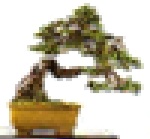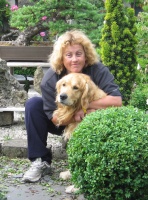Air Layering Japanese Black Pine is Difficult?
+2
Andre Beaurain
0soyoung
6 posters
Page 1 of 1
 Air Layering Japanese Black Pine is Difficult?
Air Layering Japanese Black Pine is Difficult?
I see the 'wisdom' that JBP are difficult to air layer promulgated frequently, yet don't find it at all difficult myself. I used the tourniquet method on a JBP 'thunderhead' and, even though it took 3 seasons, got roots. I girdled a branch on a JBP in my landscape and got roots in one season. I don't know the exact ages of either tree, though the wood I layered had to be well over 5 years old. On the other hand I've had more troubles with air layering Japanese Maples, which have a reputation of being 'easy' to air layer, than with JBP.
It was stated in a current thread that JBP are 'notoriously difficult' to air layer. I don't want to hijack that thread, so my question is, 'what is so difficult about air layering JBPs?'
It was stated in a current thread that JBP are 'notoriously difficult' to air layer. I don't want to hijack that thread, so my question is, 'what is so difficult about air layering JBPs?'

0soyoung- Member
 Re: Air Layering Japanese Black Pine is Difficult?
Re: Air Layering Japanese Black Pine is Difficult?
JBP ?
The novices, including myself are going to have a hard time helping you bro. To assume that everyone in the world knows all the abbreviations for every tree........
Pacific Northwest... so you live in Canada?
thanks for the new word though I'm gonna try and use it in a sentence today....'promulgated' Stunning word!
Love and light
The novices, including myself are going to have a hard time helping you bro. To assume that everyone in the world knows all the abbreviations for every tree........
Pacific Northwest... so you live in Canada?
thanks for the new word though I'm gonna try and use it in a sentence today....'promulgated' Stunning word!
Love and light

Andre Beaurain- Member
 Re: Air Layering Japanese Black Pine is Difficult?
Re: Air Layering Japanese Black Pine is Difficult?
JBP = japanese black pine.
Aerial layering is very difficult.
Best regards.
Aerial layering is very difficult.
Best regards.
Guest- Guest
 Re: Air Layering Japanese Black Pine is Difficult?
Re: Air Layering Japanese Black Pine is Difficult?
I may have two J.B.pines cuttings that took root. Will let you know next year.
Khaimraj
Khaimraj

Khaimraj Seepersad- Member
 Re: Air Layering Japanese Black Pine is Difficult?
Re: Air Layering Japanese Black Pine is Difficult?
David Cortizas wrote:JBP = japanese black pine.
..god now I feel like a tit...
o wait....
I just promulgated myself as an idiot.

Andre Beaurain- Member
 Re: Air Layering Japanese Black Pine is Difficult?
Re: Air Layering Japanese Black Pine is Difficult?
This seems to be asking a question so I'm moving it to that section. I also think this could generate some good info if people come up with responses as to why it is or indeed isn't difficult. Will be watching with an eye to its potential for becoming a Top Thread/Advanced Technique.

fiona- Member
 Re: Air Layering Japanese Black Pine is Difficult?
Re: Air Layering Japanese Black Pine is Difficult?
Hi there 0soyoung,
Here is one that I did a while back and still developing the layered tree.
I am from Melbourne, Australia. Our Spring, technically, starts in September, but sometimes as early as late July, begining of August trees start to wake up. I usually do layering anytime between beginning of August to middle of October.
This is the JBP:


At the time, it was about twelve ( 12 ) years old, ground grown, potted up for about two ( 2 ) years, one ( 1 ) was in my care. It was 122 cm tall, trunk diameter is about 10 cm.
I carried it out on 20/October/2007. The first time I ever saw roots was on 04/April/2008. The following two pictures were taken on 05/April/2008. The circles mark where the roots can be seen:


I used the ring-bark method, sphagnum moss and hardwood root hormone.
The following three pictures were taken on 13/July/2008. More roots have developed, and some others have matured:



( The roots had actually developed during Autumn. )
I started to prepare cutting it down on the 07/September/2008; I removed about 2/6 of the bark; another 2/6 every week after, till 21/September/2008 it came off.
When it had roots till cut off, I fed it diluted SUPERthrive -- an American product; cost an arm and a leg in Australia.
The layered tree:




Trunk diameter: 4.5 cm; height: 66 cm.
It had some difficult times, I guess due to potting medium that I used. It is still alive, but not much to look at... yet
This photo were taken on 05/August/2012:

The colour is much better right now.
Here is one that I did a while back and still developing the layered tree.
I am from Melbourne, Australia. Our Spring, technically, starts in September, but sometimes as early as late July, begining of August trees start to wake up. I usually do layering anytime between beginning of August to middle of October.
This is the JBP:


At the time, it was about twelve ( 12 ) years old, ground grown, potted up for about two ( 2 ) years, one ( 1 ) was in my care. It was 122 cm tall, trunk diameter is about 10 cm.
I carried it out on 20/October/2007. The first time I ever saw roots was on 04/April/2008. The following two pictures were taken on 05/April/2008. The circles mark where the roots can be seen:


I used the ring-bark method, sphagnum moss and hardwood root hormone.
The following three pictures were taken on 13/July/2008. More roots have developed, and some others have matured:



( The roots had actually developed during Autumn. )
I started to prepare cutting it down on the 07/September/2008; I removed about 2/6 of the bark; another 2/6 every week after, till 21/September/2008 it came off.
When it had roots till cut off, I fed it diluted SUPERthrive -- an American product; cost an arm and a leg in Australia.
The layered tree:




Trunk diameter: 4.5 cm; height: 66 cm.
It had some difficult times, I guess due to potting medium that I used. It is still alive, but not much to look at... yet
This photo were taken on 05/August/2012:

The colour is much better right now.
Last edited by daiviet_nguyen on Tue May 14, 2013 2:03 pm; edited 1 time in total
daiviet_nguyen- Member
 Re: Air Layering Japanese Black Pine is Difficult?
Re: Air Layering Japanese Black Pine is Difficult?
This is another of my attempts:

In the photo above, the branch in the foreground is the air-layered branch. It was carried out on the 16/October/2011. I was hoping for a seven-trunk black pine bush!
I think it is gone! The colour of the needles just keep getting "yellower" and "yellower"!
This black pine is on the ground. Very strong grower -- and this happens?
Thinking back, on the day when the air-layering was being done. I actually cut off the tip-node of this branch. I did seal it. But the bleeding was profuse.
I cannot be a 100% certain that bleeding was the cause of this failure. But it is certainly not advisable.
With my first and successful JBP layer, the needles stayed green all the way through.
I guess till October this year then!
-- That was what I posted on http://www.ausbonsai.com.au/forum/viewtopic.php?f=9&t=10891
Taking on some suggestions, I replaced the plastic with a split-pot, and the moss with normal closed potting mix. Closed means particle size of around 2 mm to 4 mm.
On the afternoon 18/February/2012, I took the plastic wrap down, and changed it:

Just split half of the pot off, the hole at the bottom should be around the thickness of the trunk. Along the vertical split, I burnt a few pairs of holes, so that I can sew it up later. On top, around the rim, I also burnt holes all around, at about equal distances; we can run wires through these holes and tie them to upper branches to hold the pot in position.

It does not have any roots, but it still looks alive? In the photo on the right, the is wire mark on the top branch, where I tied the plastic to it with a copper wire.

The pot sewed up and filled; with wires going up to keep the pot in position. I use pure scoria at the bottom half. Then mixture of 2m scoria, pine bark (orchid growing medium), and diatomite, this mixture is on top of the layer point. I also re-applied hardwood rooting powder. On the very top I put some of the moss that was taken off back. The white pebbles are to keep the birds off.
-- I will leave it there for so long as there are still green needles.
*
* *
Some observations on split-pot procedures:
It is still live. I believe I had "seen" roots on 07/April/2013. I will just have to wait till July or August 2013.

In the photo above, the branch in the foreground is the air-layered branch. It was carried out on the 16/October/2011. I was hoping for a seven-trunk black pine bush!
I think it is gone! The colour of the needles just keep getting "yellower" and "yellower"!
This black pine is on the ground. Very strong grower -- and this happens?
Thinking back, on the day when the air-layering was being done. I actually cut off the tip-node of this branch. I did seal it. But the bleeding was profuse.
I cannot be a 100% certain that bleeding was the cause of this failure. But it is certainly not advisable.
With my first and successful JBP layer, the needles stayed green all the way through.
I guess till October this year then!
-- That was what I posted on http://www.ausbonsai.com.au/forum/viewtopic.php?f=9&t=10891
Taking on some suggestions, I replaced the plastic with a split-pot, and the moss with normal closed potting mix. Closed means particle size of around 2 mm to 4 mm.
On the afternoon 18/February/2012, I took the plastic wrap down, and changed it:

Just split half of the pot off, the hole at the bottom should be around the thickness of the trunk. Along the vertical split, I burnt a few pairs of holes, so that I can sew it up later. On top, around the rim, I also burnt holes all around, at about equal distances; we can run wires through these holes and tie them to upper branches to hold the pot in position.

It does not have any roots, but it still looks alive? In the photo on the right, the is wire mark on the top branch, where I tied the plastic to it with a copper wire.

The pot sewed up and filled; with wires going up to keep the pot in position. I use pure scoria at the bottom half. Then mixture of 2m scoria, pine bark (orchid growing medium), and diatomite, this mixture is on top of the layer point. I also re-applied hardwood rooting powder. On the very top I put some of the moss that was taken off back. The white pebbles are to keep the birds off.
-- I will leave it there for so long as there are still green needles.
*
* *
Some observations on split-pot procedures:
- I used to believe that this is harder and takes longer to do than plastic wrapping. But I no longer think this is the case. It is just as easy. Especially the filling up part.
- The branch being layered should be as vertically as possible. This will help to keep the mix in the pot. I had to pull this branch back into the main trunk, and hold it in place with a cable.
- After splitting the pot, we should glue the plastic meshes onto the drainage holes and wait for the glue to dry. But ensure that the glue should not get onto the plastic meshes, thereby blocking water. Once the pot is on the branch, it is hard to keep plastic meshes in place while filling.
It is still live. I believe I had "seen" roots on 07/April/2013. I will just have to wait till July or August 2013.
daiviet_nguyen- Member
 Re: Air Layering Japanese Black Pine is Difficult?
Re: Air Layering Japanese Black Pine is Difficult?
daiviet_nguyen wrote:This is another of my attempts:
Some observations on split-pot procedures:
- I used to believe that this is harder and takes longer to do than plastic wrapping. But I no longer think this is the case. It is just as easy. Especially the filling up part.
- The branch being layered should be as vertically as possible. This will help to keep the mix in the pot. I had to pull this branch back into the main trunk, and hold it in place with a cable.
- After splitting the pot, we should glue the plastic meshes onto the drainage holes and wait for the glue to dry. But ensure that the glue should not get onto the plastic meshes, thereby blocking water. Once the pot is on the branch, it is hard to keep plastic meshes in place while filling.
I too changed to using split pots whenever possible (my experience with maples is that it saves nearly a season in root development time). I just put a little damp sphagnum in the bottom of the pot to 'screen' the drainage holes - it is far easier than gluing screen.
Referring to your first post, I too noticed that roots seem to develop in the fall, though my observations were casually done and not systematically like yours.
BTW, thanks for your very interesting posts!

0soyoung- Member
 Re: Air Layering Japanese Black Pine is Difficult?
Re: Air Layering Japanese Black Pine is Difficult?
I cut it off on the 17/07/2013. The trunk below the layer point, was pretty much dried out and had long been dead! It was effectively surviving on its own roots for some times.
It was a hectic repotting time, I completely forgot to take any photos of the root ball. But it was spread out to the diameter of the pot instead of clinging into the trunk with plastic wrapping: this is very desirable.
The following photos were taken on the 16/11/2013 -- nearly four ( 4 ) months after it was off:

View -- just a side

View -- another side

View -- The Apex
I think I can be confident that it lives. It is now 76 cm tall from the pot surface. Not much to look at as expected.
In total, it has eight ( 8 ) "trunks", three ( 3 ) are very small and very weak still. I'm hoping that with their own roots, these smaller trunks will pick up the pace somehow. I'm planing a seven-trunk tree, but that might be pushing it a bit a too much, I think a five-trunk one is quite possible.
It was a hectic repotting time, I completely forgot to take any photos of the root ball. But it was spread out to the diameter of the pot instead of clinging into the trunk with plastic wrapping: this is very desirable.
The following photos were taken on the 16/11/2013 -- nearly four ( 4 ) months after it was off:

View -- just a side

View -- another side

View -- The Apex
I think I can be confident that it lives. It is now 76 cm tall from the pot surface. Not much to look at as expected.
In total, it has eight ( 8 ) "trunks", three ( 3 ) are very small and very weak still. I'm hoping that with their own roots, these smaller trunks will pick up the pace somehow. I'm planing a seven-trunk tree, but that might be pushing it a bit a too much, I think a five-trunk one is quite possible.
0soyoung wrote:I too changed to using split pots whenever possible (my experience with maples is that it saves nearly a season in root development time). I just put a little damp sphagnum in the bottom of the pot to 'screen' the drainage holes - it is far easier than gluing screen.daiviet_nguyen wrote:This is another of my attempts:
Some observations on split-pot procedures:
- I used to believe that this is harder and takes longer to do than plastic wrapping. But I no longer think this is the case. It is just as easy. Especially the filling up part.
- The branch being layered should be as vertically as possible. This will help to keep the mix in the pot. I had to pull this branch back into the main trunk, and hold it in place with a cable.
- After splitting the pot, we should glue the plastic meshes onto the drainage holes and wait for the glue to dry. But ensure that the glue should not get onto the plastic meshes, thereby blocking water. Once the pot is on the branch, it is hard to keep plastic meshes in place while filling.
Referring to your first post, I too noticed that roots seem to develop in the fall, though my observations were casually done and not systematically like yours.
BTW, thanks for your very interesting posts!
daiviet_nguyen- Member
 Re: Air Layering Japanese Black Pine is Difficult?
Re: Air Layering Japanese Black Pine is Difficult?
Here's a picture of my JBP 'thunderhead' layer - that is a solid mass of roots (a cylinder about 4 inches deep and 4 inches in diameter). I had lots of other things to do and so did not get around to harvesting it until this past September. I probably should have done it a year ago!daiviet_nguyen wrote:I cut it off on the 17/07/2013. The trunk below the layer point, was pretty much dried out and had long been dead! It was effectively surviving on its own roots for some times.
It was a hectic repotting time, I completely forgot to take any photos of the root ball. But it was spread out to the diameter of the pot instead of clinging into the trunk with plastic wrapping: this is very desirable.


0soyoung- Member
 Re: Air Layering Japanese Black Pine is Difficult?
Re: Air Layering Japanese Black Pine is Difficult?
Japanese black pine - JBP for remainder of my post
Andre - you are funny, I enjoyed your comment and reply. Cheers man.
I found JBP to be the easiest of the pines to air layer. I have only air layered JBP 3 times, success rate 100%. The 3 cultivars were 'kyokko nishiki', a no name seedling of the cork bark type (seedling from Shig Ito) and a regular JBP seedling.
Japanese white pine - P. parvifolia, - 2 attempts, 2 failures.
Arakawa Japanese maple - one attempt, one failure.
Malus hybrid - flowering crab, one attempt, one success.
I am not systematic, I will try more maples in the future. I know my source Arakawa originally was an air layer itself, so I know it can be done. I just had an initial failure.
The malus was air layered in a split pot, in the same potting mix that it will live in for the rest of its life as bonsai. Worked well. Where I can hang a heavy (relative to tree size) pot in a tree, I think the split pot is ideal. Where weight and bulk are issues plastic wrapped sphagnum is the way to go.
Air layering, due to the time and mechanical process involved is always more time consuming than taking cuttings. But air layering is the way to go if you don't have a special mist/fog table, with bottom heat, rooting JBP and other conifers from cuttings is extremely low probability of success. (not impossible, just low probability)
You can layer off fairly old wood for most deciduous, though for the JBP my successes was only with less than 6 year old wood.
My failures were likely due to errors I made, I can tick off one or two things I could have done better for each failure.
The Japanese white pine did form a nice callus, a nice wide flared out knot, from which the roots should have formed, but after 4 years, nothing. Cut it off so I could work the rest of the tree better.
Andre - you are funny, I enjoyed your comment and reply. Cheers man.
I found JBP to be the easiest of the pines to air layer. I have only air layered JBP 3 times, success rate 100%. The 3 cultivars were 'kyokko nishiki', a no name seedling of the cork bark type (seedling from Shig Ito) and a regular JBP seedling.
Japanese white pine - P. parvifolia, - 2 attempts, 2 failures.
Arakawa Japanese maple - one attempt, one failure.
Malus hybrid - flowering crab, one attempt, one success.
I am not systematic, I will try more maples in the future. I know my source Arakawa originally was an air layer itself, so I know it can be done. I just had an initial failure.
The malus was air layered in a split pot, in the same potting mix that it will live in for the rest of its life as bonsai. Worked well. Where I can hang a heavy (relative to tree size) pot in a tree, I think the split pot is ideal. Where weight and bulk are issues plastic wrapped sphagnum is the way to go.
Air layering, due to the time and mechanical process involved is always more time consuming than taking cuttings. But air layering is the way to go if you don't have a special mist/fog table, with bottom heat, rooting JBP and other conifers from cuttings is extremely low probability of success. (not impossible, just low probability)
You can layer off fairly old wood for most deciduous, though for the JBP my successes was only with less than 6 year old wood.
My failures were likely due to errors I made, I can tick off one or two things I could have done better for each failure.
The Japanese white pine did form a nice callus, a nice wide flared out knot, from which the roots should have formed, but after 4 years, nothing. Cut it off so I could work the rest of the tree better.

Leo Schordje- Member
 Similar topics
Similar topics» Japanese Black Pine
» A Few Japanese Black Pine
» Japanese black pine
» Japanese Black Pine
» Japanese Black Pine
» A Few Japanese Black Pine
» Japanese black pine
» Japanese Black Pine
» Japanese Black Pine
Page 1 of 1
Permissions in this forum:
You cannot reply to topics in this forum






